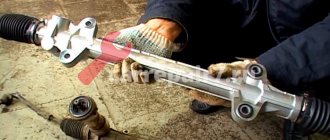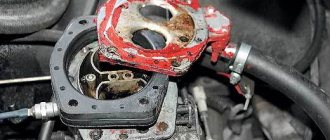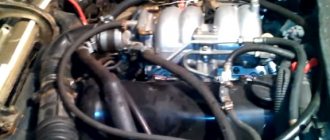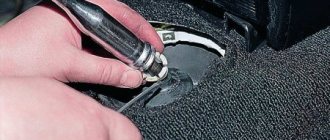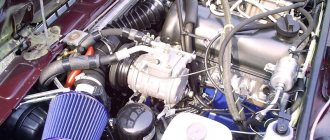The article will discuss the features of installing gas equipment on a VAZ 2106. First, let's figure out what gas can be used as fuel. You can immediately discard methane, since it requires special permits, and the car will be very expensive. In some countries, trucks use methane as fuel, but in Russia they are not used because the infrastructure is poorly developed.
Some manufacturers offer cars using a mixture of methane and diesel fuel. If possible, vehicles are fueled with methane, but if this is not possible, then they are fueled with diesel fuel. Therefore, to compare the characteristics, let’s take propane, which consumes less than butane due to its density.
What gas equipment is best to use for VAZ
For any car with a carburetor, the 1st or 2nd generation of LPG is better suited. Despite the fact that the 3rd and 4th generations are already being installed in full swing. But there is no point in installing a more modern HBO on a carburetor engine. The first generation differs from the second in little ways - only in the dispenser. The system itself is the same - the hose is connected to the carburetor through an insert into the carburetor. When a vacuum occurs in the intake manifold, it causes gas from the gearbox to flow through the dispenser into the carburetor.
In the 1st generation of gas equipment, a manual gas dispenser is used; it is enough to put it in the desired position once and there is no need to adjust it again. The 2nd generation has an electronic dispenser, which has a valve that changes its position depending on the readings of the oxygen sensor and the position of the carburetor throttle valve. Now there are many good companies that install 2nd generation gas equipment.
The second generation is not very well suited for classic carburetor VAZs, but this is not a problem; from the 2nd generation you can very easily make a 1st generation gas installation. To do this, you just need to install a mechanical dispenser instead of an electronic one.
In general, for a car with a carburetor engine, the 1st generation LPG is best suited.
How to adjust the gearbox yourself?
That's all, we figured out a little about how to install gas equipment on a car with a carburetor injection system with your own hands. Now let’s set it up correctly so that the consumption is lower and the throttle response remains the same as on gasoline. To do this, you need to use the following guide. First of all, you adjust the ignition; you need to set it a little earlier - turn the distributor body two notches (this corresponds to 10 degrees).
To make fine tuning, it is best to use electronic octane correctors. But for their normal functioning, a BSZ will be required. The reason for adjusting the ignition is that gas fuel has an octane rating of over 100. And if the adjustment is not made, the exhaust valves will burn out, and the cost of repairing them will be very significant.
You adjust the enrichment of the fuel mixture; the screw is located on the evaporator reducer. Make sure that the number of crankshaft revolutions is in the range of 800..900. Now it is necessary to adjust the gas fuel supply. To do this, you will need to screw the bolt on the valve until it stops. Then unscrew it two turns. This should be done with the engine turned off; after unscrewing the valve two turns, you can start it. Listen to how the engine works. If you sharply and briefly press the accelerator pedal, the revolutions should instantly reach 3000.
In this case, no delays should be observed. If the motor begins to “choke”, it is necessary to rotate the screw counterclockwise until this symptom disappears. You can do the entire setup yourself in just a few minutes, since only three screws can be adjusted. Screw in the second screw until it stops and turn it one turn counterclockwise. Start the engine and sharply depress the accelerator pedal.
Up to 6500 rpm, the crankshaft should spin up instantly. Please note that the second camera on a VAZ 2106 car should not open in the same way as the first. If it opens too much, the power will increase, but the consumption will increase significantly. And you won't feel any savings. Finally, the normal rotation speed is set by adjusting the XX screw.
Installation of the cylinder
To begin with, even before purchasing gas equipment, you need to decide what type of cylinder it will be: tablet-shaped or cylindrical. Usually, a cylindrical cylinder is most suitable for a classic VAZ; it has a large volume, and thanks to the large trunk, this cylinder will easily fit into it.
If the car is a hatchback, as in the 8 or 9, then it is better to install a tablet, and install it instead of a spare tire. This will save a lot of space, but you will have to drive more carefully and remember that there is no spare wheel in the car.
The cylinder must be securely fastened so that it does not dangle while driving. This is usually done using bolts and a metal stand.
After installing the cylinder, you need to decide which side the filling valve will be on. It is usually done at the bottom of the rear bumper; to do this, you need to drill a hole of the required diameter.
What to consider?
Yes, there are many nuances that you should definitely follow when installing an LPG on a VAZ 2106 car. The article contains a video that talks in more detail about all the subtleties. However, this section will be relevant for any make and model of car, as it describes the intricacies of installing gas equipment. Let's start from the very beginning - with the balloon. It must be placed in such a way that the axis of the multivalve is located at an angle to the horizontal plane.
Moreover, the angle should be exactly 30 degrees. Not a degree more or less. If installed at a different angle, the FLS will show “weather” and the fuel intake from the tank will be unstable. Therefore, when installation is carried out, you need to pay attention to all, even the most insignificant, points, otherwise the cost of incorrect installation will be incredibly high.
The refueling fitting on a VAZ 2106 car is best secured in the rear, right under the bumper. The line is laid along the bottom of the car. All this work should be carried out in an inspection hole, since it is almost impossible to install tubes without it. Laying them with your own hands is quite simple. The main thing is to install the line next to the gasoline line. You can even attach it to the gasoline pipe using plastic ties.
There are no special requirements for the fuel selection button. The most important condition is that it is convenient to turn it on. To install the gasoline valve, you need to cut the fuel hose between the pump and the carburetor. But the gas one must be installed in the engine compartment on the right side. Pay attention to the installation of the evaporator reducer. It is not difficult to install it with your own hands, but you must adhere to some requirements:
- Its location should be lower than the uppermost pipe going to the stove.
- Its location should be longitudinal, this will avoid problems with the diaphragm during sudden acceleration or braking.
The installation of the mixer also has some features. It is installed in the carburetor, located between two halves - the throttle body and the carburetor itself. Of course, the height increases, so you need to purchase the required number of bolts. Their length should be three turns longer than the standard ones.
Installation of gas pipeline wiring
Next, you need to deal with the gas pipeline wiring. It is necessary to drill a hole from the cylinder valve to the engine compartment. Moreover, the gas pipeline is usually run along the bottom of the car.
To ventilate the multivalve, you need to drill a hole with a slightly larger diameter and insert a piece of plastic pipe into this hole.
These inserted tubes must be treated with mastic to prevent rust from appearing in the future. You need to run a gas line through these plastic tubes and secure it well so that it stays away from the moving parts in the car.
HBO VAZ 2101: video
Practicing lawyer with 10 years of experience. Specializations: criminal law, insurance law, administrative offenses.
The price of installing LPG on a car consists of the cost of the selected set of equipment (brc, lovato, digitronic), installation work, consumables (pipes, hoses, clamps), type and volume of the cylinder installed in the cabin (toroidal/cylindrical).
We have inexpensive prices for installing gas equipment.
All prices are given on a turnkey basis and include the cost of: equipment + installation + consumables + cylinder (standard).
The cost of work varies if non-standard work is performed (for example, whether or not removal of the intake manifold is required, we will hang the cylinder from the body or mount it horizontally in the trunk, etc.) and select a cylinder of a larger volume.
Installation of a gasoline electric valve
The gasoline valve must be installed on the side of the pipeline supply to the gasoline pump. The valve is installed in the pipeline; to do this, you need to cut the pipeline, insert the valve there, and then use clamps to securely clamp the pipeline.
The main thing to understand is that the valve is located in the fuel line that runs from the fuel pump to the carburetor. The main thing is that the valve is not placed in front of the fuel pump, because while shutting off and supplying gasoline, the fuel pump will not be able to supply gasoline to the carburetor.
VAZ-2106. The hard way
Almost a year has passed since the start of our “gas test drive”. We can sum up the first results.
Department of Expertise
Almost a year has passed since the beginning of our “gas test drive”. We can sum up the first results.
VAZ-2106 © Photo: 5 wheel
Regular readers probably remember: we converted two rear-wheel drive Zhiguli cars to run on liquefied gas. Considering the rich biography of the “veterans”, the replacement of units and bodies, we will simply keep silent about the models.
On gas they started with 1.6-liter engines, then - for various reasons - they were replaced. However, first things first.
The engine of the first test subject, a VAZ-2106, run on gasoline, faithfully went 10 thousand km and gave way to the one and a half liter VAZ-2103 for reasons not related to the test. The successor went through 100 thousand before being installed on the “carrier” and was rebuilt for preventive reasons. The production of cylinders and crankshaft journals remained within acceptable limits, so the matter was limited to the installation of new SM piston rings, domestic liners, oil seals, gaskets and Goetze oil reflecting caps. An anti-friction coating from VMP-Auto was applied to the piston skirts as an experiment.
Opening the removed engine did not reveal any anomalies. The only malfunction is oil leakage through the front crankshaft oil seal, which is bad for a new engine, but has nothing to do with gas.
We have already written about our first impressions of driving propane-butane. As soon as the problems with the “outgoing” adjustments ended, failures began - electronics, gearboxes, valves. A year later, all that was left of the “original” set of equipment were cylinders and pipelines. We don’t dare blame the manufacturer - St. Petersburg: before installation on the cars, the equipment was collecting dust in the garage for several years, and time is destructive for rubber diaphragms.
New gearboxes were installed, now not with electronic, but with vacuum control. The changes were felt immediately - failures, unstable idling.
Through adjustments (made by the installer and independently), the reception and idle speed were brought to an acceptable level. But, admittedly, the old gearbox behaved better when it worked. What kind of country are we in that they can’t really make electronics or rubber?..
They began to drive more calmly, consoling themselves with the fact that it was cheaper. Although the savings are relative. Gas consumption in the city does not drop below 12 liters per 100 kilometers. On gasoline it is possible to keep within the top ten. The price of the cheapest “ninety-second” in St. Petersburg is 6.90, the most expensive gas is 5.00. It seems that gas station workers are very keen to put themselves out of work. The only consolation is that there is propane in the city for 4.20.
Our second ward was less fortunate. The engine was assembled from what was left of the car's turbulent racing past. The most important thing is that a “clamped” block head was used. On the one hand, a compression ratio of about 11 made it possible to switch to gas without losing dynamics, on the other hand, it caused inconvenience and even technical problems. The first is the need, as an alternative to gas, to refuel with “ninety-eighth” gasoline, which is both expensive and relatively scarce. The second was discovered when disassembling the engine.
After “running” about 25 thousand kilometers, the engine began to smoke. When removing the head, we were surprised by the abundance of carbon deposits on the piston heads. This should not happen on a gas engine. There were two malfunctions - one “from above”, the other “from below”. The valve stem seals have become stiff, completely losing their elasticity. One of the guide bushings had a millimeter (!) groove. To our shame, we initially did not bother to measure the “combat” head, therefore we cannot say with certainty whether wear arose when working on gas, or whether the destructive process that began earlier was just accelerated. But the “wooden” caps are, without a doubt, on the conscience of gas. More precisely, non-optimal ignition timing. The exhaust valve seals suffered more damage, which is easily explained. Ignition too late with slow-burning gas led to the fact that the fuel charge burned out already in the exhaust tract. This results in overheating and hardening of the rubber.
There is also a “lower” problem associated with ignition - burnout of the jumper between the piston ring grooves in one of the cylinders. But in our opinion, it is not gas that is to blame for this, but gasoline, which we still had to drive from time to time. It was not always possible (and, frankly, desirable) to fill a “shaggy” car of an unknown year of manufacture with “ninety-eighth” gasoline. And on other grades, the engine, as a rule, worked with detonation. What made the situation worse was the fact that I didn’t want to crawl under the hood every time to turn up the ignition.
Now the same sports head is installed on the rebuilt “bottom”. We envy those who use branded gas equipment: on some models, the ignition timing changes automatically when switching from one type of fuel to another.
But we are not looking for easy ways. Since at this stage of testing we are consciously dealing only with domestic equipment, then we will try to cope with the problem of “switching” the ignition using domestic means.
By the way
The ignition system of a gas engine requires a special approach. To reliably ignite the combustible mixture, increased voltage is required; starting a cold engine is difficult. The temperature in the combustion chamber is higher (see graph). To solve these problems, the Czech company Brisk proposes to use special Brisk Silver spark plugs in engines running on liquefied petroleum gas (propane-butane). Gas ignition is improved by changing the design of the arrester. The diameter of the middle silver electrode is reduced, the distance between the electrodes is 0.55 mm. The silver electrode ensures the stability of the spark plug parameters throughout its entire service life. The high thermal conductivity of silver allows the use of a longer insulator tip. Brisk Silver “gas” spark plugs can also be used when the engine is running on gasoline.
By the way-2
The operating process of the engine when running on gas is somewhat different from the “classic gasoline” one. The combustion of the gas-air mixture occurs more slowly, the temperature in the combustion chamber is higher, and the oil film is not washed off from the cylinder walls by fuel drops. There are also differences in chemistry. When gasoline containing sulfur is burned, sulfates and sulfuric acid gradually accumulate in the crankcase. The gas produces nitrates and nitric acid.
Many of the world's leading petroleum product manufacturers produce special motor oils for gas engines. Their main feature is reduced sulfate ash content (0.3-0.6% instead of 0.8-1.5%). The additive package is selected in such a way as to most effectively neutralize nitrogen compounds and prevent premature aging (oxidation and thermal destruction) of the oil.
Unfortunately, gas refineries most often mean almost exclusively large-displacement stationary engines. As a result, products intended for them are either manufactured to the specifications of specific engine manufacturers or do not fall under existing “automotive” classifications.
Our quick analysis of the products offered on the Russian market allows us to conclude that the only one who cares about gas cars is the Italian... Fiat.
VS Gas oil, produced by FL Italia, part of the concern, is both automobile, motor, and gas. Considering the pedigree of AvtoVAZ, our Zhiguli drivers should be happy. But does everyone who drives gas really need to switch to Italian oil? We did not find any references in the information of other manufacturers to the possibility of using their materials in automotive gas engines. Everywhere there is only gasoline and diesel, with and without turbocharging and catalyst. Meanwhile, some auto specifications (DAF MAT 703 10, MAN M3271, MB 226.9, etc.).
Specialists from a research center belonging to one of the world leaders in the production of lubricants, in a personal conversation with a representative of the examination department of our magazine, argued that their products are completely “compatible” with gasoline, diesel fuel, and gases (natural and liquefied petroleum ). Nevertheless, in all the company’s automotive materials brochures there is not a word about gas, but there is a special section “Oils for gas engines.” The theoretical question remains open. We really hope that experts will join the conversation on this topic.
In the meantime, we can only advise you not to neglect the established oil change intervals. For reference and comparison: FL Italia recommends replacing VS Gas after 10 thousand km in gasoline engines and 15 thousand in gas engines.
The editors recommend:
Why do piston rings stick and how to prevent it?
A traffic police officer searched my car: did he have the right to do so?
Russians may be left without foreign cars: Western automakers have stopped supplying cars to our country
A ship that was transporting cars to Russia was detained in France
One hundred dollars: how much will car prices now increase?
News Media2
Discussion Cancel
I want to receive the most interesting articles
How to install a gas valve
It is best to install the gas valve away from the gasoline valve; the further away, the safer. But the place must be accessible so that you can always reach the gas valve. A gas wire must be connected to the gas valve, which has already been laid from the gas cylinder to the engine. Next, we will discuss in more detail how to install the gearbox, control panel and dispenser.
About the Avtogaz-Moscow service
For 14 years, we have installed HBO on almost all popular models. It is convenient to combine the installation of HBO with routine vehicle maintenance. Within 5 hours we will install gas on your 2106 and, if desired, replace air filters, spark plugs, high-voltage wires, etc.
LPG suppliers in Russia
We are suppliers of gas equipment in the Russian Federation. We work only with proven European manufacturers. We are confident in the quality of the equipment we offer.
We provide a guarantee for up to 5 years!
cars equipped in our service
We install gas equipment
kilometers average payback of equipment
guarantee for all gas installation work
Gas reducer and its installation
It is best to install the gas reducer near the carburetor, and it should stand vertically to ensure a full gas supply; in addition, it is advisable to connect the reducer to the pipes going to the stove.
To do this, you need to use 2 tees and cut into the stove pipes. It is important that the inlet pipe of the gearbox cuts into the inlet pipe of the stove, and into the outlet pipe - the outlet pipe. And a gas pipeline must be connected to the reducer, which comes from the shut-off valve.
Setting up the vacuum reducer
There are two types of vacuum reducers:
- providing separate adjustment at idle speed, as well as sensitivity;
- having a combined regulator of these two settings.
In the first case, the adjustment is carried out similarly to the adjustment of the electronic gear described above. If the regulator is combined, as in the 2nd generation Lovato LPG for cars with a carburetor, the adjustment is as follows:
- the car starts using gas, the speed is adjusted by suction, up to two thousand per minute;
- the choke is gradually removed, the speed is set to maximum by tightening the screw that adjusts the idle speed;
- The same adjustment adjusts the number of revolutions, about a thousand per minute or a little more;
- With a similar setting, the speed is further reduced below the nominal value, and then again rises to a thousand per minute.
This is how the 2nd generation Lovato LPG is configured for the carburetor.
Installation of a gas mixture dispenser
Now it’s time to install the gas mixture dispenser; it is placed between the mixer and the gearbox, but it is also better to install it close to the carburetor. A gas pipeline must be installed to the dispenser, which comes from the reducer, and a gas pipeline must be led from it to the mixer.
The most important thing is that all the gas equipment parts are fixed in place, and the entire system is sealed.
How to choose the type of gas
When choosing equipment, it is necessary to decide not only on the generation, but also on the type of fuel. Car cylinders can be refilled:
Let's briefly talk about the advantages and disadvantages. Propane does not require a thick-walled tank. Therefore, the container does not take up much space and has less weight, and this is important for VAZ passenger cars.
Propane gas stations are widely available throughout the country. The cost of a propane-butane installation is less, but the gas itself is more expensive than methane.
There are very few methane gas stations today. The cost of methane gas equipment is higher, and its dimensions and weight are greater.
Advantages of natural gas:
- saving money;
- safety;
- environmental friendliness.
For example, for the first version of the VAZ 2110 with 8 valves and Euro-2 standard, installing a methane-fueled gas system will make emissions cleaner and protect engine parts from carbon deposits. But methane cylinders are heavier, take up more space, and are more expensive to install, so such equipment is rarely installed on LADA.
Why is this necessary?
Gas bottled equipment is an affordable upgrade for almost any car, in which the engine fuel system is changed and the owner has the opportunity to alternatively use environmentally friendly and economical fuel, without giving up traditional gasoline. The advantages of the installation are significant:
- Saving fuel costs by an average of a third (this is a real figure based on vehicle operation).
- Smoother and quieter engine operation
- The octane number of propane-butane (the main type of gas fuel in the Russian Federation) is more than 102 and therefore its combustion takes place without residual deposits, which has a positive effect on the durability of the engine.
- Increases vehicle range without refueling
- The release of harmful substances into the atmosphere is reduced by 70%
There is one serious minus, since installing LPG is a significant intervention in the engine design, the car will most likely be removed from warranty repairs at branded car services . Well, the gas cylinder itself, in modern systems, is made for installation instead of a spare wheel, and therefore the spare wheel will have to be moved to the luggage compartment, seriously reducing its volume.
Cost savings
The cost of installing LPG depends on several factors. The final price is influenced primarily by the equipment supplier . Now, in the Russian HBO market, manufacturers from a dozen and a half countries are fighting among themselves. From the simplest domestically developed models and budget options from Belarus and Ukraine to premium kits costing over 100,000 rubles from Italian, Australian, and South Korean companies.
All current gas-cylinder equipment is divided into 6 generations , and the first three, due to their primitiveness, are no longer installed in most services, and the 5th and 6th generations are designed for cars with an injection-type engine. Well, the more cylinders in a car engine, the more expensive the installed gas cylinder equipment system will be.
For example, if you install an economy class system, 2nd generation, on a 4-cylinder engine with a cylindrical cylinder with a volume of 50 liters, then the price, in most cases, will not exceed 20,000 rubles . And the cost of re-equipping a new 8-cylinder engine with a 4th generation Italian-made gas injection system, with a 95 liter toroidal cylinder with installation of a filling device in the gas tank hatch, with a EURO multi-valve will start from 70,000 rubles .
